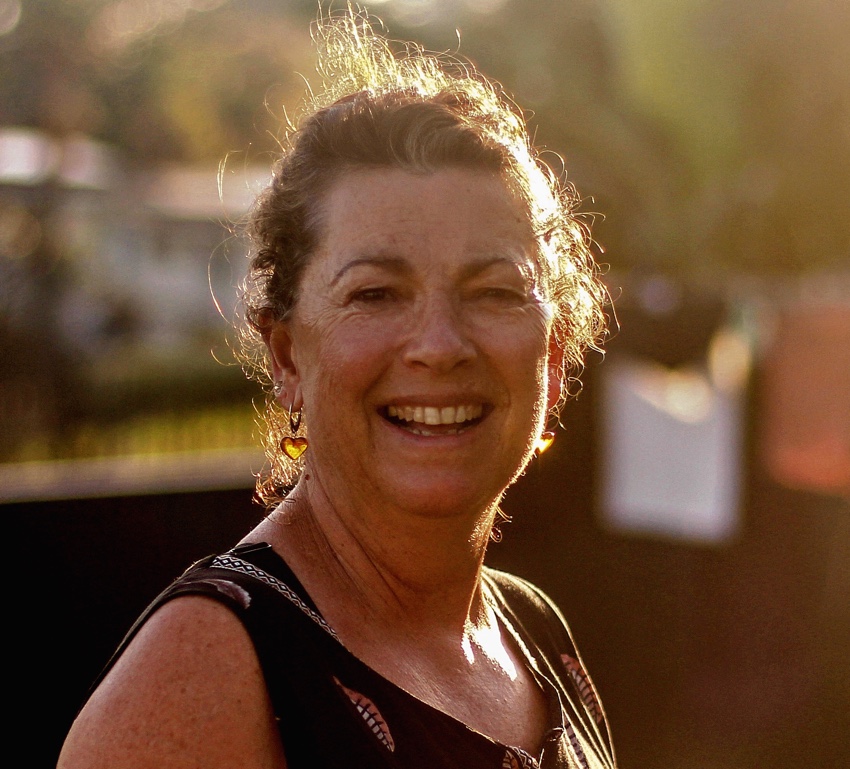 This week my guest, Liza Perrat, originates from the other side of the world. She grew up in Australia, working as a general nurse and midwife. She’s now been living in France for over twenty years, where she works as a medical translator and a novelist. This week my guest, Liza Perrat, originates from the other side of the world. She grew up in Australia, working as a general nurse and midwife. She’s now been living in France for over twenty years, where she works as a medical translator and a novelist.
Liza’s books include The Bone Angel historical fiction series – three standalone French village stories spanning six hundred years. Three midwife-healer women are linked by a bone angel talisman during the French Revolution (Spirit of Lost Angels), WW2 Nazi-occupied France (Wolfsangel) and the 1348 Black Plague (Blood Rose Angel).
The Silent Kookaburra is the first novel in her Australian 1970s drama series. The second is The Swooping Magpie and the third, The Lost Blackbird.
Over to Liza!
I left Australia to come and live in France almost twenty-eight years ago where, sadly, my midwifery and nursing qualifications weren’t recognised. So that put a stop to my career in the medical field, coupled with my two young children and number three not far behind!
I’d always been a voracious reader and had entertained thoughts of creative writing when I was young and I think that living in a French village and being surrounded by all this old European history, as opposed to Australia’s very recent history, gave me the idea to write an historical novel. I love historical fiction as a means of learning about history without an academic lesson and I’m also passionate about history so, in hindsight, it’s no surprise I ended up writing about it.
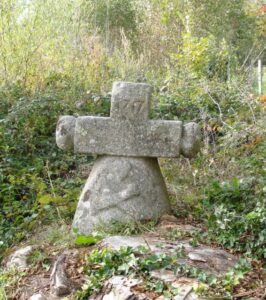 The first novel idea came to me on a Sunday walk along the riverbank near our home. I came across a stone cross (croix à gros ventre, or “Cross with the big belly”). Dated 1717, it commemorates two children who drowned in the river. The first novel idea came to me on a Sunday walk along the riverbank near our home. I came across a stone cross (croix à gros ventre, or “Cross with the big belly”). Dated 1717, it commemorates two children who drowned in the river.
Who were they? How did they drown, and where are they buried? I wanted to know more about them; to give them names, a family, a village. An identity. I felt the urge to write the story of these lost children, and was pleased to discover our village has a local history centre (L’Araire) staffed with very helpful volunteers. I’ve since made numerous visits there, for my subsequent novels. Sadly, there was no information on these drowned children, except that they were four and five years old, and are buried in the neighbouring village cemetery. So I used my newly-acquired research to imagine what they’d been like; to conjure up their family, their village, their identities, so I could bring them to life.
The children had died in the same century as the French Revolution took place, and that seemed the most obvious setting: the peasants versus the aristocracy – on the small scale of my story, paralleled with the larger, real-life scale. A dramatic backdrop for the dramatic event of their drowning. This story became my first novel, Spirit of Lost Angels.
It started out as a one-off standalone, however once it was finished, I realised there were more stories to tell about the village of Lucie-sur-Vionne (fictional, though based on where I live), the farmhouse (L’Auberge des Anges), and the family who own it. I’d also learned that this was a very active French Resistance area during the Nazi Occupation of Lyon in WW2, so the second in the series, Wolfsangel was based around that idea.
I’d used dramatic historical events for the settings of these books and by the time I reached the third novel, I’d become intrigued by the medieval period. So the bubonic plague seemed a logical choice for the setting of Blood Rose Angel: one woman fighting against the village, symbolising the people of the world battling against the greater enemy of Black Death.
Each book can be read as a standalone even though the bone angel talisman links each heroine, and the stories all deal with the same family, the same farmhouse and the same French village.
There’s much I miss about Australia: family, friends, the space, the lovely beaches and the easy way of life. However, there’s much I love about my new home country, France: the history, the old architecture, the age-old yarns and tales. And I doubt very much I’d have discovered the joy of writing historical fiction had I not come to live in a French village.
—————
Connect with Liza
Website and blog: http://www.lizaperrat.com/
Follow Liza on BOOKBUB
Facebook: https://www.facebook.com/Liza-Perrat-232382930192297
—————
I loved Liza’sBone Angel series set here in France, but she draws on her Australian roots for The Lost Blackbird.
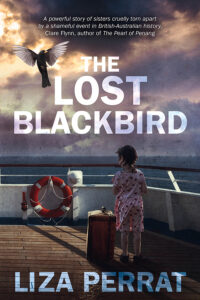 London 1962. A strict and loveless English children’s home, or the promise of Australian sunshine, sandy beaches and eating fruit straight from the tree. Which would you choose? London 1962. A strict and loveless English children’s home, or the promise of Australian sunshine, sandy beaches and eating fruit straight from the tree. Which would you choose?
Ten-year-old Lucy Rivers and her five-year-old sister Charly are thrilled when a child migrant scheme offers them the chance to escape their miserable past.
But on arrival in Sydney, the girls discover their fantasy future is more nightmare than dream.
Lucy’s lot is near-slavery at Seabreeze Farm where living conditions are inhuman, the flies and heat unbearable and the owner a sadistic bully. What must she do to survive?
Meanwhile Charly, adopted by the nurturing and privileged Ashwood family, gradually senses that her new parents are hiding something. When the truth emerges, the whole family crumbles. Can Charly recover from this bittersweet deception?
Will the sisters, stranded miles apart in a strange country, ever find each other again?
A poignant testament to child migrants who suffered unforgivable evil, The Lost Blackbird explores the power of family bonds and our desire to know who we are.
Buy from Amazon UK Amazon US Amazon AUS
Alison Morton is the author of Roma Nova thrillers – INCEPTIO, CARINA (novella), PERFIDITAS, SUCCESSIO, AURELIA, NEXUS (novella), INSURRECTIO and RETALIO, and ROMA NOVA EXTRA, a collection of short stories. Audiobooks are available for four of the series. Double Identity, a contemporary conspiracy, starts a new series of thrillers.
Find out more about Roma Nova, its origins, stories and heroines and taste world the latest contemporary thriller Double Identity… Download ‘Welcome to Alison Morton’s Thriller Worlds’, a FREE eBook, as a thank you gift when you sign up to Alison’s monthly email newsletter. You’ll also be among the first to know about news and book progress before everybody else, and take part in giveaways.
If you enjoyed this post, do share it with your friends!Like this:Like Loading...
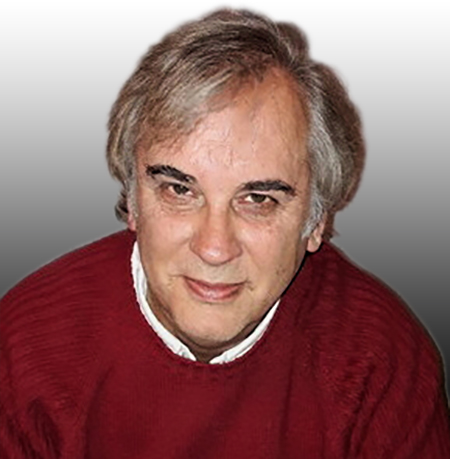 I’m delighted to welcome crime writer Keith Dixon to the writing blog as the latest guest in the ‘writers abroad’ series. We actually met up in 2019 in Montmorillon, where Keith lives and which turns out to be pivotal to this post… Keith was born in Yorkshire and grew up in the Midlands. He’s been writing since he was thirteen years old in a number of different genres: thriller, espionage, science fiction, literary. I’m delighted to welcome crime writer Keith Dixon to the writing blog as the latest guest in the ‘writers abroad’ series. We actually met up in 2019 in Montmorillon, where Keith lives and which turns out to be pivotal to this post… Keith was born in Yorkshire and grew up in the Midlands. He’s been writing since he was thirteen years old in a number of different genres: thriller, espionage, science fiction, literary.
Two-time winner of the Chanticleer Reviews CLUE First in Category award for Private Eye/Noir novel, he’s the author of ten full-length books and one short-story in the Sam Dyke Investigations series and two other non-crime works, as well as two collections of blog posts on the craft of writing and a series of videos. His new series of Paul Storey Thrillers began in 2016 and there are now three books in the series.
Over to Keith!
My interest in France began when I was 10 years old. My junior school in Coventry was one of the first to introduce French-language teaching, which they did by importing an American teacher to give us an hour a week to point at a wall and say, ‘le mur’ and then point at a window and say ‘la fenêtre’. He also arrived with armfuls of Paris Match magazines, of which I took half a dozen copies home to look at the pictures. France was a strangely captivating country, at least according to the photographs.
I later took ‘O’ and ‘A’ level qualifications in French and made my first trips to France when I was 18 and then 19. It was still the era of the franc, and being limited to taking the equivalent of £50 into the country – in my case, hoping to make that last 3 weeks, topping up with travellers’ cheques if necessary. (Do they even still exist?) With two friends I travelled through the country marvelling at how different the pronunciation of the language was by real French people compared to that of my teachers in England. When did ‘vingt’ become ‘vengt’?
But my ambition to live in France as a writer was crystalised by watching a TV programme. It was an interview with Lawrence Durrell, brother of the more famous Gerald, but well-known nonetheless as a writer of literary novels like those contained in The Alexandria Quartet. I don’t remember much about the interview, but I do recall the final shot: Durrell, in the paved courtyard of his (presumably rented) château, sitting on a chair in nothing but his shorts, typing away on an old upright typewriter while taking in the glorious sunshine. I thought: ‘That’s the life for me!’
Half a century on, it came to pass!
I started writing short stories and play scripts in my mid-teens, and later took a degree in Creative Writing and Drama. I wrote 7 full-length novels between the ages of 20 and 22 and while I had an agent, I couldn’t quite get traction. And then life intervened and I had to make a living. As it happened many of the jobs I took had creative writing as one of their components – proofreader, copywriter, online editor, elearning creator, management course designer.
And eventually I was able to begin coming over to France again, making the move permanent at the end of 2015.
 Montmorillon today (Photos: Steve Morton, Alison Morton) By this time I’d started writing a series of novels based on a British private eye living in the North West of England—Sam Dyke. Although I’d taught ‘serious’ literature for a while (one of the jobs that didn’t involve my own writing!), most of my own reading for pleasure had become American crime writing. So when I returned to writing myself I wanted to write in that genre and thus invented this Yorkshire PI working in the posh suburbs of Cheshire.
And the connection with the SAS in Vienne, 1944?
And then … I was staying in the Vienne, in central France, when I went for coffee with friends in a café and met an Englishmen touring the area by bicycle. He told us why he was here, mentioning an operation from World War II called Operation Bulbasket. This was one of the newly-formed SAS’s first operations, taking place slightly before and then after D-Day, 6 June 1944. A cadre of SAS soldiers was parachuted into the area around Montmorillon with instructions to impede the process of German reinforcements as they headed north to combat the British and American troops landing in Normandy. They ended up bivouacking in the nearby forest of Verrières, from which they carried out a number of sabotage operations on German rail and road transport. It seemed they were eventually betrayed and 30 British soldiers and 1 American airman were executed and buried.
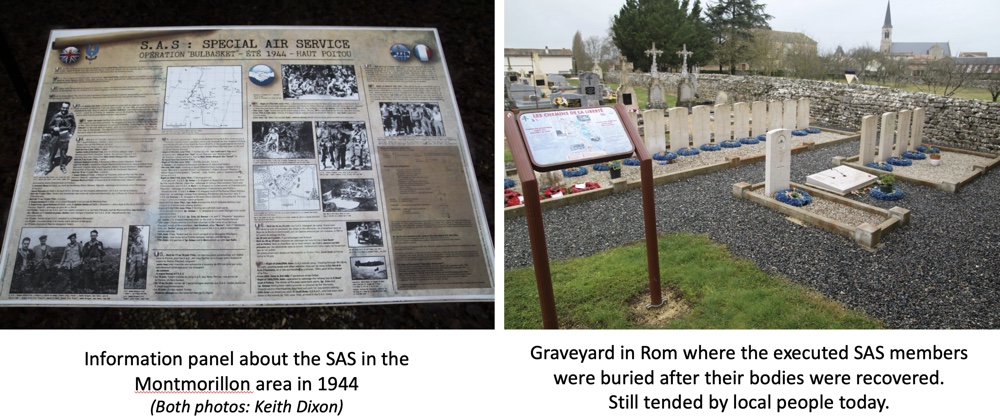
As all writers recognise, hearing this story immediately set the creative juices flowing! Although my PI was definitely based in the UK, in contemporary times, I worked out a plot that had a ‘backstory’ involving a Frenchman working with the maquis in 1944, a secret letter from Churchill, and another well-known story from WWII, the sinking of a steamer called The Struma which was carrying nearly 800 Jewish refugees from Romania to Palestine when it was sunk in the Black Sea, leaving only one survivor. I visited the sites where the SAS had lived, and where they had died. In the book I used my knowledge of Montmorillon and other local villages.
The resulting book was called The Hard Swim, and takes place in Edinburgh, Crewe, Portsmouth and Montmorillon, and wouldn’t have been written had I not happened to be in Montmorillon, taking coffee with friends, and hearing this story from a descendant of one of those executed in a forest in 1944.
What a story of bravery and sacrifice. Thank you so much, Keith. Montmorillon is such a pretty and peaceful town today. Known as ‘la cité de l’écrit’ (city of writing), it has countless bookshops, a book-oriented cultural life and a typewriter museum!
————
Connect with Keith
Website: www.keithdixonnovels.com
Blog: www.cwconfidential.blogspot.com
Twitter: https://twitter.com/keithyd6 @keithyd6
Facebook: https://www.facebook.com/idlewriter
Instagram: https://www.instagram.com/theidlewriter/
YouTube Channel: Crime Writing Confidential:
https://www.youtube.com/channel/UCGIWF78f9rxuZGOAZpP-6Yw
————
Read The Hard Swim
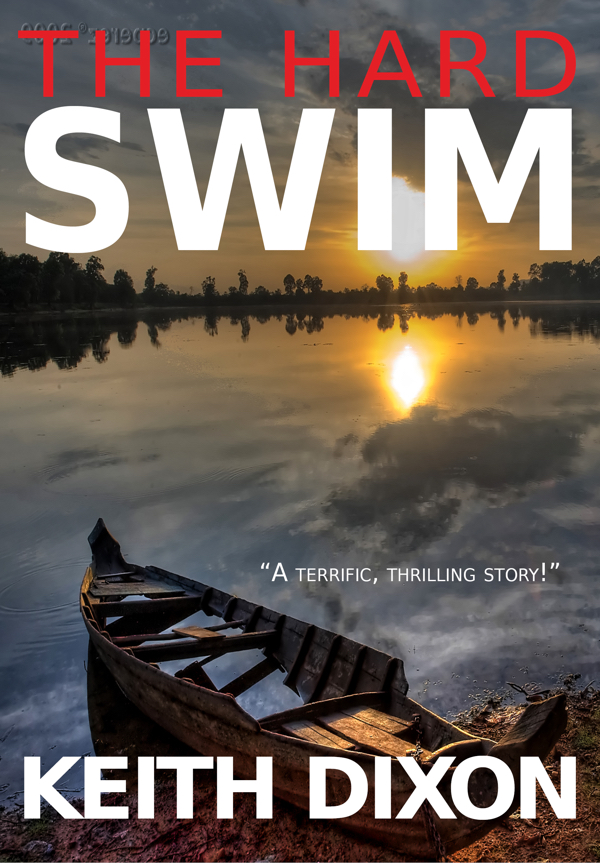 FEBRUARY 1942: The Struma, a broken-down steamer, explodes and sinks in the Black Sea, drowning 768 Rumanian Jews fleeing the Nazis and heading for Palestine, and safety. FEBRUARY 1942: The Struma, a broken-down steamer, explodes and sinks in the Black Sea, drowning 768 Rumanian Jews fleeing the Nazis and heading for Palestine, and safety.
JUNE 1944: Thirty-one SAS soldiers are captured behind enemy lines and are forced to dig their own graves before being shot and buried in a forest in the heart of France.
SEVENTY YEARS LATER: A young woman is attacked in the grounds of Edinburgh Zoo – the attacker seeking the document that might link these two wartime events.
Private Investigator Sam Dyke becomes involved in unravelling a mystery that dates back to the Second World War. He rescues a woman who’s on the point of being abducted and, for all he knows, murdered. He helps the woman, Chantal Bressette, escape, subsequently learning that she’s carrying a document of vital importance to a group of powerful people.
Sam Dyke discovers he’s the only one who can stop them.
Based on true events, and with action ranging from Edinburgh through to a quiet village in the centre of France, The Hard Swim pits Sam Dyke against his toughest opponents yet—an experienced team of killers backed by a ruthless MP about to ascend to one of the great roles of state.
Buying link: (ebook) http://authl.it/B00BL9FUOU?d
Keith’s Amazon page: https://www.amazon.co.uk/Keith-Dixon/e/B0034OO9BK
Alison Morton is the author of Roma Nova thrillers – INCEPTIO, CARINA (novella), PERFIDITAS, SUCCESSIO, AURELIA, NEXUS (novella), INSURRECTIO and RETALIO, and ROMA NOVA EXTRA, a collection of short stories. Audiobooks are available for four of the series. Double Identity, a contemporary conspiracy, starts a new series of thrillers.
Find out more about Roma Nova, its origins, stories and heroines and taste world the latest contemporary thriller Double Identity… Download ‘Welcome to Alison Morton’s Thriller Worlds’, a FREE eBook, as a thank you gift when you sign up to Alison’s monthly email newsletter. You’ll also be among the first to know about news and book progress before everybody else, and take part in giveaways.
If you enjoyed this post, do share it with your friends!Like this:Like Loading...
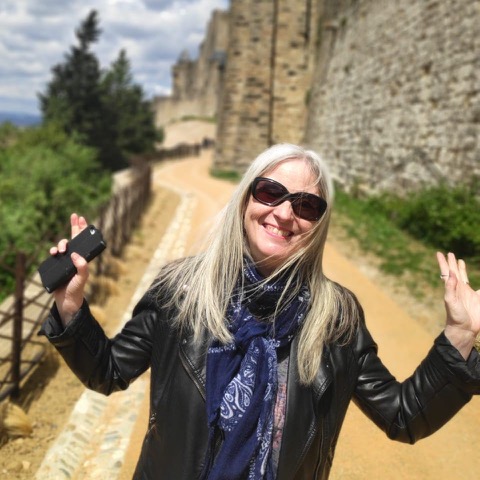 This week, I’m delighted to welcome Cathie Dunn to the blog in the ‘writers abroad’ series. She is an award-winning author of historical fiction, mystery, dual-timeline, and romance set in Scotland, England, and France. She has been praised for her authentic depiction of the past. After many years in Scotland, Cathie now lives in the south of France. She loves to hear from her readers. This week, I’m delighted to welcome Cathie Dunn to the blog in the ‘writers abroad’ series. She is an award-winning author of historical fiction, mystery, dual-timeline, and romance set in Scotland, England, and France. She has been praised for her authentic depiction of the past. After many years in Scotland, Cathie now lives in the south of France. She loves to hear from her readers.
Over to Cathie!
Thank you for hosting me today, Alison. I’m delighted to be here, and to chat about the place that inspired my bestselling dual-timeline novel, Love Lost in Time.
You see, I live in Carcassonne, a large historic town in the south of France. Readers may have heard of it, especially fans of novels by Kate Mosse. But Ms Mosse isn’t the only author taking advantage of Carcassonne’s rich history.
So let me take you to the sweeping plain that sits between the Pyrenees to the south and the foothills of the Massif Central to the north, where you’ll find a real treasure: Carcassonne!
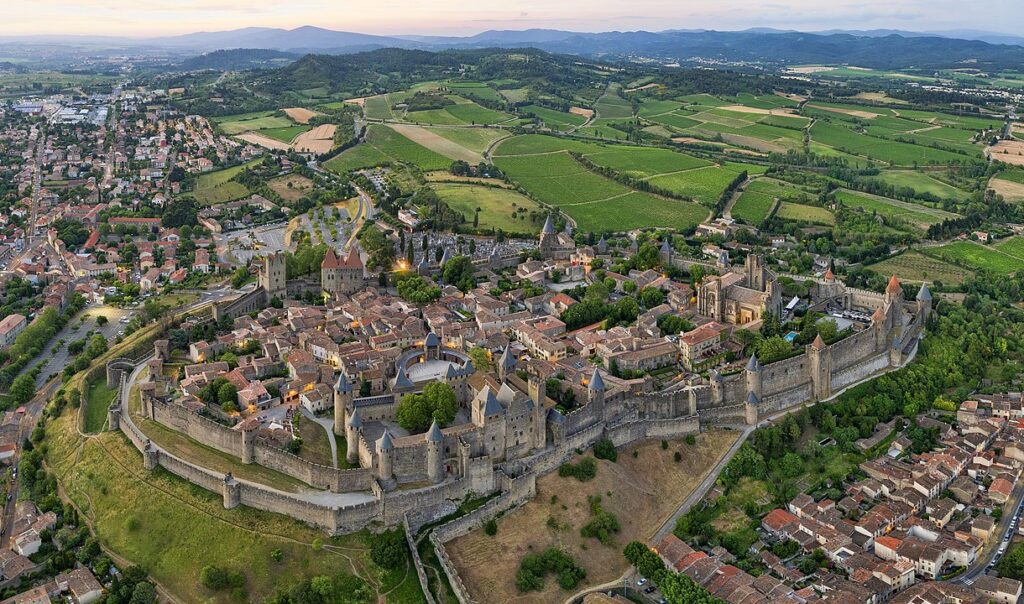 Carcassonne from the air (Photo: Chensiyuan CC licence) For centuries, there have been two sides to the town: the ancient citadel with its château comtal up high on a hill (now known as ville haute or La Cité) and the lower town (ville basse), which includes the medieval bastide, a fortified extension to the ancient fortress built at the foot of the mount where there also used to be a large barbican, sadly lost to time.
The hill La Cité sits on was already occupied during the Neolithic period, its elevated position allowing for sweeping views over the plain below. Archaeological evidence has been found of many such settlements across the area.
The Romans agreed with the strategic setting, and soon built a stone wall around their early settlement as fortification. They recognised the value of this outpost on a busy trading route. You can still see original Roman stones, including at the base of the inner wall. More evidence of Roman occupation, such as burial slabs, distance markers and original tiles, are exhibited inside the château.
In the dying years of the Roman Empire, the Visigoths arrived and settled. Septimania – the region west of the Mediterranean Sea – officially ceded to them in 462. A couple of centuries later, the Saracens arrived.
In the late 750s and early 760s, the Franks, under Pepin le Bref (the Short), succeeded in confining the Saracens to the coast and to Iberia. It was in the late 8th century that Bellon, the first Count of Carcassonne, lived. We know very little about him, but he was likely of Visigoth origins. I took the liberty of re-creating his life in Love Lost in Time. A true warrior of his time, but with a heart. (And a good read, too – Alison)
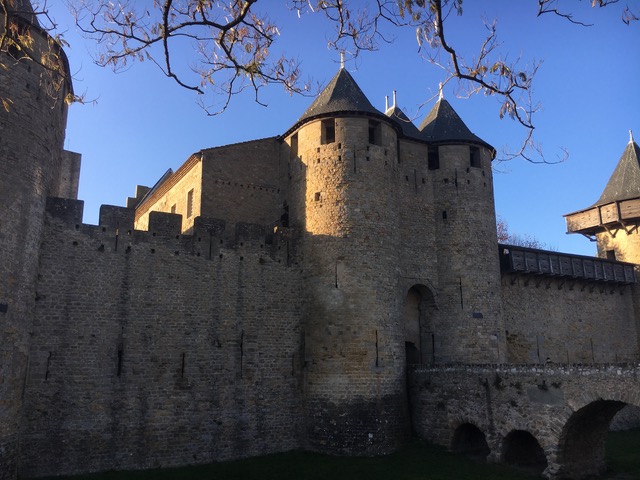 Entrance to the Château Comtal The era, with the dominance of the Franks becoming apparent, is a fascinating one. In the late 770s and 780s, Charlemagne was keen to fortify his power base in the south, and the impressive sites like Carcassonne, and other hilltop forts dotted strategically north of the Pyrenees, provided a suitable buffer against Saracen Iberia.
Local leaders like Bellon would have thrived under the Franks, provided they remained loyal. His people benefitted from Frankish advances such as enhanced education, new laws, and increased trade.
The tribes, long subdued by incessant fighting between Visigoths, Saracens and Franks, returned to the valleys for a more stable life, secure under the protection of the powerful Franks. But dangers still lurked in pockets of uprisings. It was at the hands of the Basques that Charlemagne experienced one of his worst defeats during his campaigns, at Roncesvalles in 778.
What a gift for a writer!
For me, this mix of old and new, of Pagan, Catholic and Saracen, formed the basis of the plot in Love Lost in Time. In the present-day part, Maddie inherits an old property just north of Carcassonne, in the dramatic Cabardès hills. In the historic part of the novel, Hilda (the wife I created for Bellon) is sneaking out of the fortress to follow her calling as a healer. It is both in the Cabardès hills as well as ancient Carcassonne that the two stories cross over.
Carcassonne is of course best-known for being a home of the Cathars – a group of dualists who the Catholic Church persecuted in the 13th century. In 1209, the fortress fell to the ‘crusaders’ – sent by Pope Innocent III to either convert or kill the ‘heathens’ – for the first time. Viscount Raymond-Roger de Trencavel – whose family had built and held the castle for over a century – was thrown in his own gaol where he died in unexplained circumstances. It is an intriguing event I’ve included in a new writing project, a medieval murder mystery.
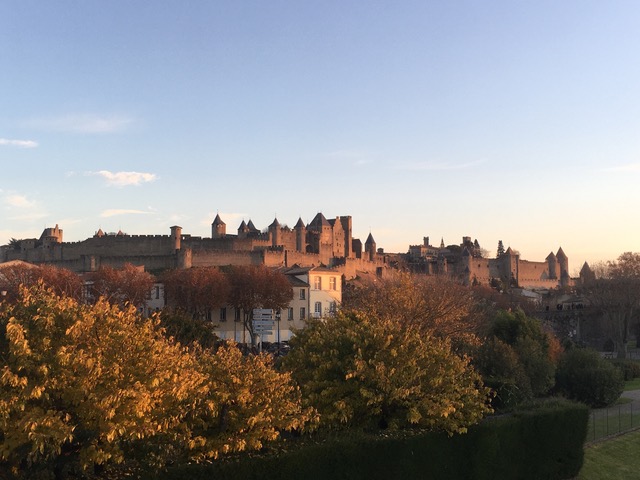 The citadel from the river Centuries later, with the Spanish border defined, the old fortress fell into disrepair. It was in the second half of the 19thcentury, that the architect Eugène Viollet-le-Duc gave the citadel a new lease of life. But his refurbishments didn’t all go down too well, with some regarding his fairy-tale turrets and conical roofs as too stylised, although old drawings prove his decision right in some respects.
Nowadays, Carcassonne is still an incredible place to visit – and to live in. I’m fortunate enough to be able to just head up to La Cité for a stroll. I’ve lost count as to how often I’ve taken the wall walk, accessible through entry into the château, and I love looking around, imagining medieval life in those walls.
So, should you ever find yourself in the western Mediterranean, make sure to stop off at Carcassonne, and let the old walls, the bustling narrow lanes, and the enormous amount of local history draw you in.
Thank you again, Alison, for letting me chat about this wonderful place. I hope to welcome you to Carcassonne soon.
Thank you so much, Cathie. I visited Carcassonne when a lot younger and loved it. On my list to re-visit in the next 12 months.
———–
Connect with Cathie
Website: www.cathiedunn.com
Twitter: https://twitter.com/cathiedunn @cathiedunn
Facebook: https://www.facebook.com/CathieDunnAuthor
Amazon author page: author.to/CathieDunn
———–
What’s Love Lost in Time about?
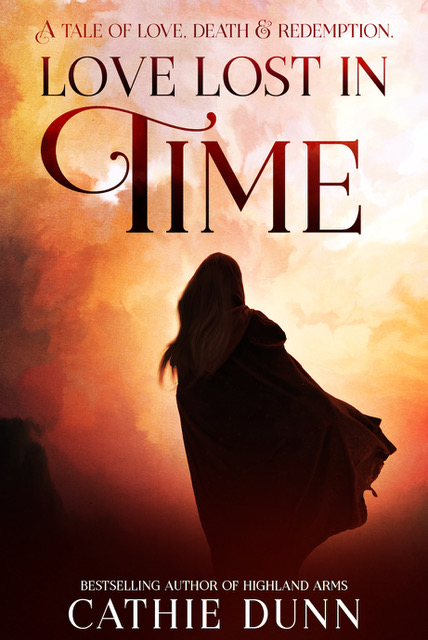 Languedoc, France, 2018 Languedoc, France, 2018
Historian Madeleine Winters would rather research her next project than rehash the strained relationship she had with her late mother. However, to claim her inheritance, she reluctantly agrees to stay the one year required in her late mother’s French home and begins renovations. But when she’s haunted by a female voice inside the house and tremors emanating from beneath her kitchen floorboards, she’s shocked to discover ancient human bones.
The Mediterranean coast, AD 777
Seventeen-year-old Nanthild is wise enough to know her place. Hiding her Pagan wisdom and dutifully accepting her political marriage, she’s surprised when she falls for her Christian husband, the Count of Carcassonne. But she struggles to keep her forbidden religious beliefs and her healing skills secret while her spouse goes off to fight in a terrible, bloody war.
As Maddie settles into her rustic village life, she becomes obsessed with unraveling the mysterious history buried in her new home. And when Nanthild is caught in the snare of an envious man, she’s terrified she’ll never embrace her beloved again.
Can two women torn apart by centuries help each other finally find peace?
Buy Love Lost in Time: Amazon UK Amazon US Amazon FR
Alison Morton is the author of Roma Nova thrillers – INCEPTIO, CARINA (novella), PERFIDITAS, SUCCESSIO, AURELIA, NEXUS (novella), INSURRECTIO and RETALIO, and ROMA NOVA EXTRA, a collection of short stories. Audiobooks are available for four of the series. Double Identity, a contemporary conspiracy, starts a new series of thrillers.
Find out more about Roma Nova, its origins, stories and heroines and taste world the latest contemporary thriller Double Identity… Download ‘Welcome to Alison Morton’s Thriller Worlds’, a FREE eBook, as a thank you gift when you sign up to Alison’s monthly email newsletter. You’ll also be among the first to know about news and book progress before everybody else, and take part in giveaways.
If you enjoyed this post, do share it with your friends!Like this:Like Loading...
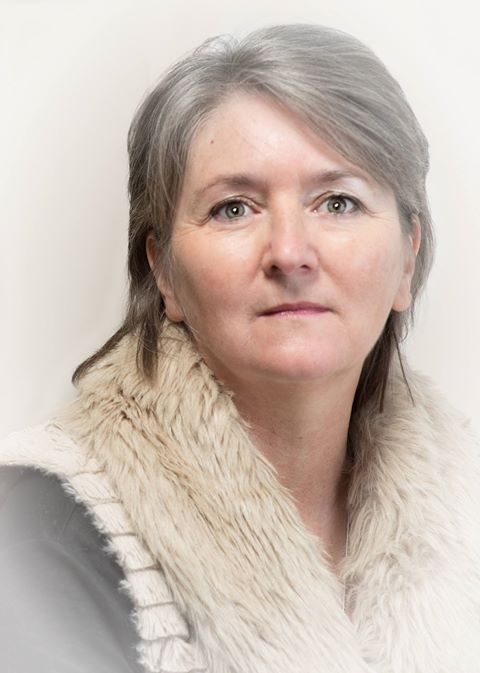
This week’s guest in the writers abroad series, Jean Gill, is an award-winning writer and photographer who left rainy Wales in 2003 to follow her creative dreams in Provence. She lives with two scruffy dogs, a Nikon D750, a beehive named Endeavour,and a man. For many years, she taught English in Wales and was the first woman to be a secondary headteacher in Wales. She is mother or stepmother to five children so life was hectic.
Since her first book of poetry was published in 1988, Jean has written twenty-three books in various genres. She is best known for her recent historical fiction and fantasy novels but her work also includes a popular dog book and a cookery book on goat cheese. With Scottish parents, an English birthplace and French residence, she can usually support the winning team on most sporting occasions.
Over to Jean to reveal her particular terroir…
I imagine myself back in that Swansea café thirty-six years ago. The Man’s eyes are an intense blue as he says, ‘I’d like to take you to the south of France.’
With hindsight I reply, ‘One day, we’ll be dressed in white suits, stumbling around a Provençal hill-side in the dark, carrying a beehive full of honeybees.’
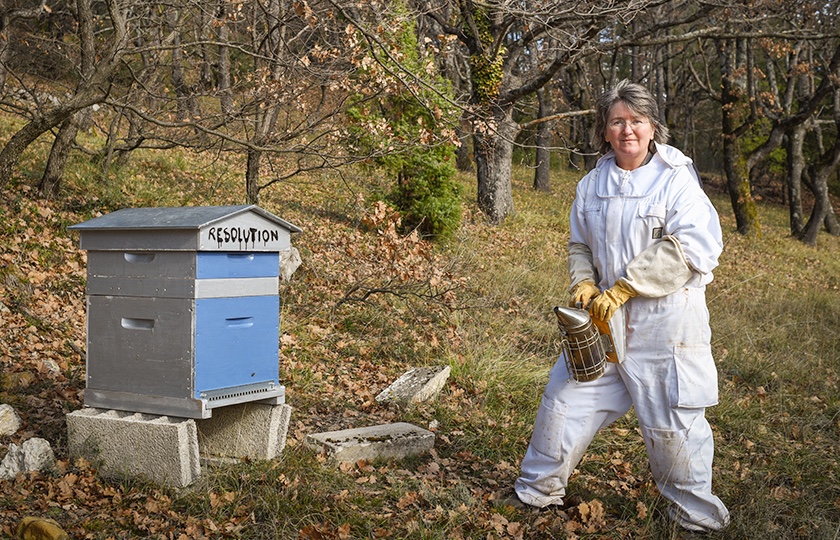
Maybe he’d have thought twice about a shared future.
But there we were on a balmy August night, waiting for the bees to go to bed so we could shut their entrance with foam, carry the hive off to the car and relocate it in a carefully prepared site in our orchard.
On hot summer evenings, bees cluster around their entrance like neighbours gossiping on the porch, and we waited a long time until they headed for bed. Then we secured the hive with leather belts and took the new lodgers home.
My Beemaster had given me full instructions on how to recuperate the hive he’d carefully nurtured for me but I was no longer the apprentice. These were my bees now and I’d watched them from the moment we caught the swarm hanging on a branch. This swarm was destined for me, much to the envy of the other learners, who all wanted bee colonies.I was also there when the Beemaster painted a pink spot on the queen – the colour code for that year. I called the queen Lily the Pink, knowing already that naming bees leads to heartache but unable to resist the temptation.
So began my first year beekeeping in 2015, after two years’ practical course. My sole aim was to keep bees alive but in a good year we do harvest the honey and have fifty jars of amber sweetness stored in the cellar. Nothing tastes as good as the honey harvest from your own bees, working on your own ‘terroir’, the French word that means so much more than ‘land’. ‘Home’, ‘soil’, ‘origin’ all contribute to the flavour of ‘terroir’.
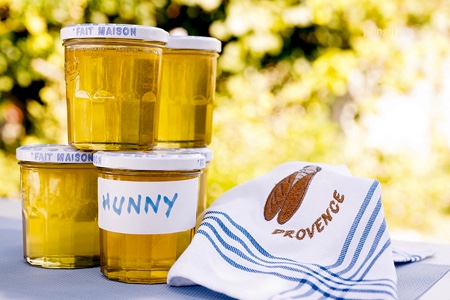
When I taste our honey, I taste the garrigue, herbs and wildflowers, or the sap of holm oak trees after it’s been processed by ants. I’ve watched my bees harvesting this glistening ‘honeydew’ from the leaves of truffle oaks in our orchard. Each harvest is a different colour, depending on weather, flowers in bloom and time of harvest.
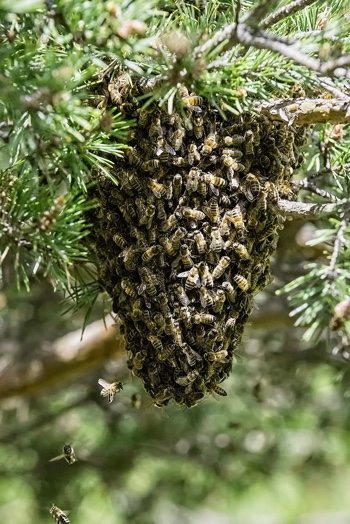 Everything a beekeeper does is a judgement call, based on personal philosophy and analysis of the bees’ needs. If it was easy to help bees thrive these days, it wouldn’t be as important, so there are highs and lows as we fight against the damage caused by pesticides, environmental destruction, climate change and human ignorance. Everything a beekeeper does is a judgement call, based on personal philosophy and analysis of the bees’ needs. If it was easy to help bees thrive these days, it wouldn’t be as important, so there are highs and lows as we fight against the damage caused by pesticides, environmental destruction, climate change and human ignorance.
Wouldn’t it be amazing if we could shift shape into bees, enter a beehive and experience life as bees? How different that mindset would be from our human obsessions with individuality and rights. How different would be our vision of the natural world, not just in adding ultra-violets to our colour spectrum and losing red, but in being part of a super-organism, a hive mind.
A writer only has to wonder, ‘What if?’ for a story to begin working its magic. In this case the story of a misfit girl, stung by wild bees in the forbidden forest and reborn as their shape-shifting queen. A story written from love of bees.
All photos © Jean Gill
Thank you, Jean. I love watching the bees busy around the lavender, sage and rosemary in my garden. Busy little people!
———–
Find out more about Jean
Website: www.jeangill.com
Twitter: https://twitter.com/writerjeangill @writerjeangill
Facebook: https://www.facebook.com/writerjeangill
Instagram: https://www.instagram.com/writerjeangill/
———–
And now, a terrific offer from Jean!
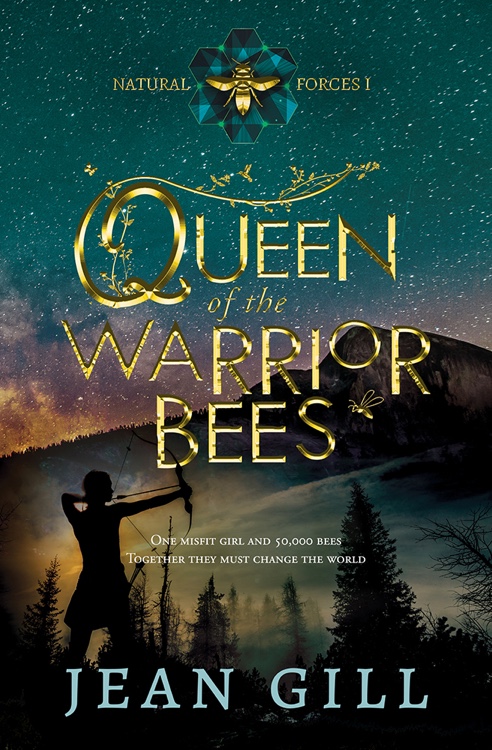
Award-winning epic eco-fantasy
One misfit girl and 50,000 bees against the might of the Citadel.
Mielitta, a despised servant of dubious parentage, yearns to be an adult and fit into Citadel society but the all-powerful mages won’t even consider her for the Maturity Test. As they fight amongst themselves, Mielitta overhears their secrets and plans to escape.
Bastien and Jannlou, the boys who terrorised her as a child, have grown into their status as Mages and she cannot escape them forever.
In desperation, she flees to the forbidden Forest and its dangerous attractions. Her scent angers thousands of bees and, although she survives their attack, she has changed. As a bee-shifter, Mielitta sees the world differently.
This bond works both ways and the bees need Mielitta’s help as the rift widens between Forest and Citadel. Can Mielitta find the fulfilment she craves or will the Mages crush every cell of her second nature?
Block Nature out and she’ll force a way in.
‘Gill’s work stands apart through its strikingly inventive concept, distinctive sense of place, and masterful use of imagery.‘ The Booklife Prize
Queen of the Warrior Bees is FREE until 31 May – https://books2read.com/QueenBee
Alison Morton is the author of Roma Nova thrillers – INCEPTIO, CARINA (novella), PERFIDITAS, SUCCESSIO, AURELIA, NEXUS (novella), INSURRECTIO and RETALIO, and ROMA NOVA EXTRA, a collection of short stories. Audiobooks are available for four of the series. Double Identity, a contemporary conspiracy, starts a new series of thrillers.
Find out more about Roma Nova, its origins, stories and heroines and taste world the latest contemporary thriller Double Identity… Download ‘Welcome to Alison Morton’s Thriller Worlds’, a FREE eBook, as a thank you gift when you sign up to Alison’s monthly email newsletter. You’ll also be among the first to know about news and book progress before everybody else, and take part in giveaways.
If you enjoyed this post, do share it with your friends!Like this:Like Loading...
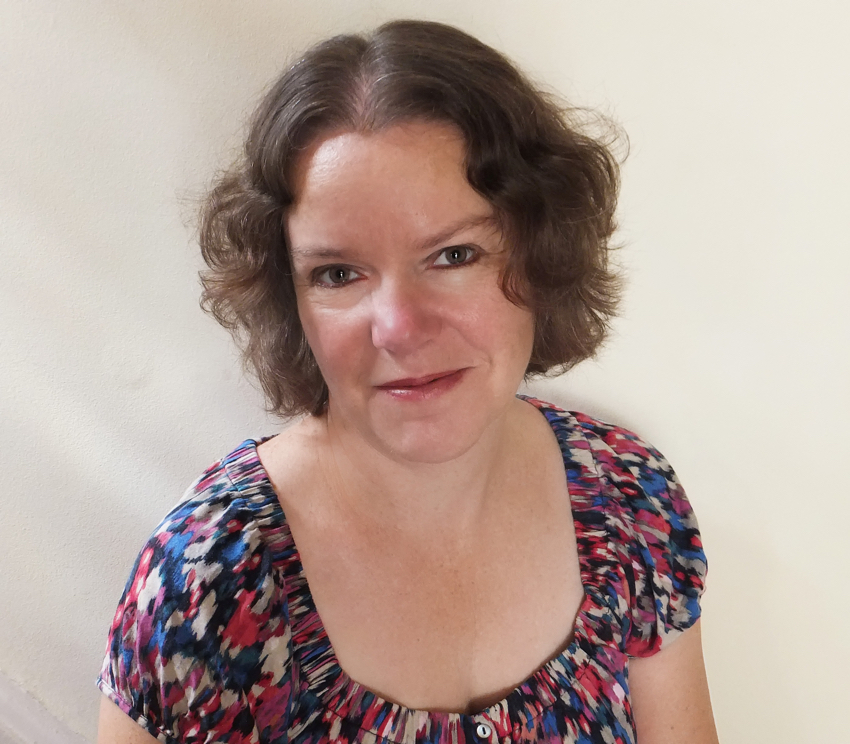 This week’s guest in the writers abroad series, Kathleen McGurl, actually lives in Christchurch, England but when pandemics allow she spends a lot of time travelling in Europe with her husband in their motorhome, especially France and Spain. She has written ten dual timeline novels, set in England, France and Ireland, and is constantly inspired by the history of any place she finds herself in. This week’s guest in the writers abroad series, Kathleen McGurl, actually lives in Christchurch, England but when pandemics allow she spends a lot of time travelling in Europe with her husband in their motorhome, especially France and Spain. She has written ten dual timeline novels, set in England, France and Ireland, and is constantly inspired by the history of any place she finds herself in.
Over to Kathleen!
I write dual timeline novels, where a historical mystery is uncovered and resolved in the present day. I write the two storylines as alternating chapters. It’s a tricky genre to write, as each novel needs two sets of characters and two plot-lines, yet must hang together as a single story.
One way to tie the two timelines together is by using a strong and distinctive setting, that is ‘seen’ by the reader in both time periods. Often the location has changed dramatically over the decades or centuries between the two storylines. I’ve used a west of Ireland village abandoned during the 1840s famine (The Girl from Ballymor); a Lake District valley evacuated and flooded to make way for a reservoir which then dried out during a drought (The Drowned Village); and a large country house that’s now a hotel (The Daughters of Red Hill Hall).
In The Secret of the Château, it’s probably no surprise that the setting is a French château. The historical story is set during the French revolution, when it is lived in for the last time by members of the doomed aristocracy. And in the contemporary story, I had a group of newly retired friends decide to pool their resources and buy it – something I’ve dreamed of doing with my mates!
 I’d seen a small château in the Loire valley that had inspired my book, and took some photos of it to use when writing it. But my favourite part of France is the Alpes-Maritimes. I’m a mountain lover, and being near the Alps while also within easy reach of the Mediterranean coastline is my idea of heaven. So I decided to uproot my château and put it in one of the high valleys where I’d spent a couple of months touring, in 2019. I’d seen a small château in the Loire valley that had inspired my book, and took some photos of it to use when writing it. But my favourite part of France is the Alpes-Maritimes. I’m a mountain lover, and being near the Alps while also within easy reach of the Mediterranean coastline is my idea of heaven. So I decided to uproot my château and put it in one of the high valleys where I’d spent a couple of months touring, in 2019.
There aren’t so many châteaux in that area, but there are enough that my story was plausible, and I very much enjoyed having my contemporary character go for walks in the local hills as well as visit the nearby village, shopping in the market, watching the locals play pétanque etc. It was a fun book to write, and my research was helped immensely by having spent those weeks touring the area in our motorhome.
Covid-19 and lockdowns have meant our travelling has been severely restricted recently. Thankfully I came up with an idea for a novel set right where I live – Christchurch, England, and that’s my current work-in-progress. I hadn’t realised until I moved here in December 2020 that it was a hotbed of smuggling in the 18th century. With the help of the local library I’ve researched its history thoroughly and have come up with a dual timeline novel that encompasses many real-life local smuggling stories. I am having a wonderful time writing it!
My newest completed book is The Lost Sister (publication date 12th May 2021). It tells the story of three sisters who work on three sister ships – Olympic, Titanic and Britannic. Much of the setting of the historical story is on board the ships, so of course this research had to be done via books. That worked, during the pandemic.
Soon we’ll be able to travel again, I hope. I have a novel in mind set in Dublin during the 1916 uprising, and another set in Chamonix, France. Before I embark on either book I’d like to go back to these areas and really immerse myself in the locations.
————-
Connect with Kathleen
Website: https://kathleenmcgurl.com
Twitter: https://twitter.com/KathMcGurl @KathMcGurl
Facebook page: https://www.facebook.com/KathleenMcGurl
————-
Discover more about The Secret of the Château…
(Which I enjoyed immensely and recommend!)

1789. Pierre and Catherine Aubert, the Comte and Comtesse de Verais, have fled the palace of Versailles for their château, deep in the French Alps. But as revolution spreads through the country, even hidden away the Auberts will not be safe forever. Soon they must make a terrible decision in order to protect themselves, and their children, from harm.
Present day. When Lu’s mother dies leaving her heartbroken, the chance to move to a château in the south of France with her husband and best friends seems an opportunity for a new beginning. But Lu can’t resist digging into their new home’s history, and when she stumbles across the unexplained disappearance of Catherine Aubert, the château begins to reveal its secrets – and a mystery unsolved for centuries is uncovered…
Buy from Amazon UK
Alison Morton is the author of Roma Nova thrillers – INCEPTIO, CARINA (novella), PERFIDITAS, SUCCESSIO, AURELIA, NEXUS (novella), INSURRECTIO and RETALIO, and ROMA NOVA EXTRA, a collection of short stories. Audiobooks are available for four of the series. Double Identity, a contemporary conspiracy, starts a new series of thrillers.
Find out more about Roma Nova, its origins, stories and heroines and taste world the latest contemporary thriller Double Identity… Download ‘Welcome to Alison Morton’s Thriller Worlds’, a FREE eBook, as a thank you gift when you sign up to Alison’s monthly email newsletter. You’ll also be among the first to know about news and book progress before everybody else, and take part in giveaways.
If you enjoyed this post, do share it with your friends!Like this:Like Loading...
|
Subscribe to Blog via Email
Join 368 other subscribers.
Categories
Archive
|
 This week my guest, Liza Perrat, originates from the other side of the world. She grew up in Australia, working as a general nurse and midwife. She’s now been living in France for over twenty years, where she works as a medical translator and a novelist.
This week my guest, Liza Perrat, originates from the other side of the world. She grew up in Australia, working as a general nurse and midwife. She’s now been living in France for over twenty years, where she works as a medical translator and a novelist. The first novel idea came to me on a Sunday walk along the riverbank near our home. I came across a stone cross (croix à gros ventre, or “Cross with the big belly”). Dated 1717, it commemorates two children who drowned in the river.
The first novel idea came to me on a Sunday walk along the riverbank near our home. I came across a stone cross (croix à gros ventre, or “Cross with the big belly”). Dated 1717, it commemorates two children who drowned in the river. London 1962. A strict and loveless English children’s home, or the promise of Australian sunshine, sandy beaches and eating fruit straight from the tree. Which would you choose?
London 1962. A strict and loveless English children’s home, or the promise of Australian sunshine, sandy beaches and eating fruit straight from the tree. Which would you choose?


























